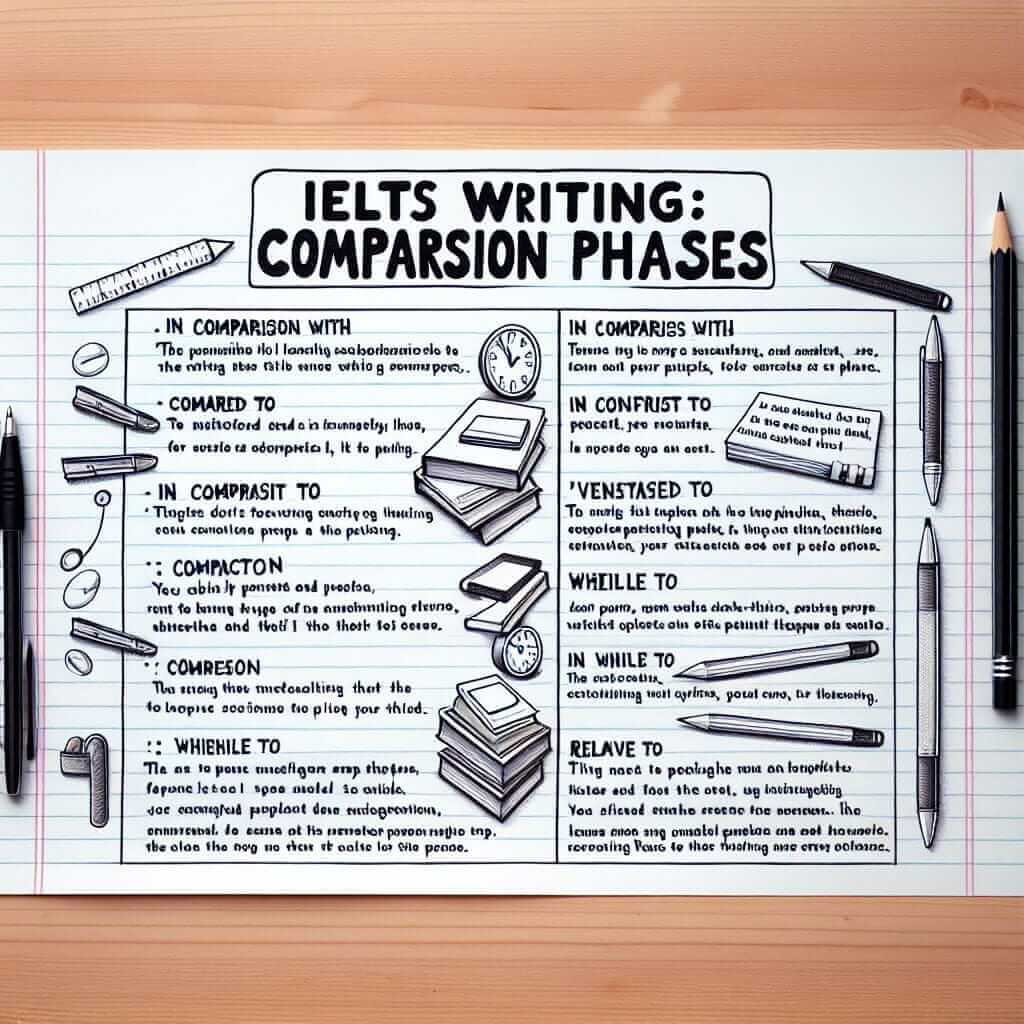“In comparison with” is a powerful phrase to have in your IELTS writing arsenal, especially for Task 1 when you need to compare and contrast data or trends. Mastering this phrase, along with its synonyms and related structures, will not only boost your vocabulary score but also enable you to present information more clearly and cohesively, ultimately contributing to a higher band score. Let’s explore how to make the most of this versatile phrase.
For instance, you might say:
- “In comparison with 1990 levels, CO2 emissions in 2020 had doubled, indicating a concerning environmental trend.” (This sentence compares data points across two different years.)
- “The unemployment rate in city A remained stable. In comparison, city B saw a significant decrease.” (This sentence contrasts trends in two different locations.)
- “In comparison with their peers in developed countries, young people in developing nations often face greater barriers to education.” (This sentence compares a situation across different groups.)
As you can see, “in comparison with” is flexible and can be used to compare various elements within your IELTS Writing Task 1 response.
Understanding “In Comparison With”
This phrase signifies the act of evaluating similarities or differences between two or more entities. You’re essentially holding one up against the other to highlight how they measure up. It’s like holding two pieces of fabric side-by-side to see which one is brighter.
The beauty of “in comparison with” lies in its formality and neutrality. It presents a balanced view without implying any inherent superiority or inferiority. This makes it highly appropriate for the academic tone expected in IELTS Writing.
Mastering the Grammar of “In Comparison With”
While the concept is simple, using “in comparison with” effectively requires grammatical precision:
Formula:
[Element 1] + in comparison with + [Element 2]
Breakdown:
- Element 1: The first item, trend, or group you are comparing.
- In comparison with: The phrase signaling the comparison.
- Element 2: The second item, trend, or group serving as the basis for comparison.
Let’s look at some examples and dissect them:
-
Sentence: “In comparison with the dramatic increase in car usage, public transportation usage remained relatively flat.”
- Element 1: “the dramatic increase in car usage”
- Element 2: “public transportation usage remained relatively flat”
-
Sentence: “Salaries in the technology sector were significantly higher in comparison with those in education.”
- Element 1: “Salaries in the technology sector”
- Element 2: “those in education” (referring to salaries)
Applying “In Comparison With” to IELTS Writing
Task 1:
This phrase is your best friend for Task 1, especially when analyzing charts, graphs, or tables.
Example:
“The graph illustrates the changing consumption habits of tea and coffee in the UK. In comparison with the steady decline in tea consumption from 1980 to 2020, coffee consumption experienced a gradual but consistent increase over the same period.”
Task 2:
While less common in Task 2, “in comparison with” can be used effectively in essays that require you to compare and contrast different ideas, solutions, or perspectives.
Example:
“Some argue that economic growth should be prioritized to address poverty. In comparison with this viewpoint, others believe that focusing on social welfare programs is a more direct and effective approach.”

Reaching for a Higher Band Score: Synonyms and Variations
To further showcase your lexical resource, use these synonyms and phrases similar to “in comparison with” in your IELTS writing:
- Compared to/with
- In contrast to (use this when highlighting differences)
- Whereas (for presenting contrasting elements)
- While (for simultaneous comparison)
- Relative to
You can learn more about using “whereas” for comparison here.
Using these effectively will demonstrate a wider range of vocabulary and a stronger command of English.
Common Errors and How to Avoid Them
-
Incorrect pronoun usage: Ensure the pronouns used after “in comparison with” correctly refer back to the elements being compared.
- Incorrect: “The cost of living in New York is much higher in comparison with San Francisco, but it also has its advantages.”
- Correct: “The cost of living in New York is much higher in comparison with that of San Francisco, but it also has its advantages.”
-
False parallelism: Maintain grammatical consistency in the phrases you’re comparing.
- Incorrect: “The new model is lighter, faster, and in comparison with the older one, more fuel-efficient.”
- Correct: “The new model is lighter, faster, and more fuel-efficient in comparison with the older one.”
By being mindful of these common errors, you can ensure that your use of “in comparison with” is accurate and strengthens your IELTS writing, rather than detracting from it.
Conclusion
“In comparison with” is more than just a phrase; it’s a tool for clarity and effective communication. By understanding its nuances, practicing its application, and exploring its synonyms, you can significantly enhance your ability to analyze and present information convincingly in your IELTS Writing tasks. Remember, consistent effort and a focus on accuracy are key to achieving your desired band score.